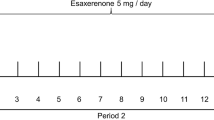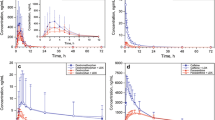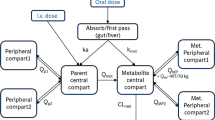Abstract
Purpose
In vitro data showed that selexipag and its active metabolite (ACT-333679) have an inductive effect on CYP3A4, CYP2B6, and CYP2C9 at concentrations approximately 100-fold higher than the maximum plasma concentration (C max) measured under steady-state conditions. In order to confirm in vivo the lack of induction at the enterocyte level, we assessed the effect of selexipag on midazolam, a substrate of hepatic and intestinal CYP3A4.
Methods
This study was conducted according to an open-label, randomized, two-way crossover design. A total of 20 subjects received a single oral dose of 7.5 mg midazolam alone (treatment A) or on top of steady-state selexipag (treatment B). Selexipag was administered twice daily using an up-titration scheme consisting of three steps: 400, 600, 1000, and 1600 μg with increments every fourth day. A 24-h pharmacokinetic profile was performed following midazolam administration, and bioequivalence criteria were investigated on an exploratory basis.
Results
The C max of midazolam and 1-hydroxymidazolam was decreased by approximately 20 and 14%, respectively, following treatment B compared to A. The time to reach C max for midazolam and 1-hydroxymidazolam was similar between treatments. The terminal half-life was reduced in treatment B compared to A for both midazolam (16%) and 1-hydroxymidazolam (20%). Exposure (area under the curve) to midazolam and 1-hydroxymidazolam was similar between treatments, and the 90% confidence intervals of geometric mean ratios were within the bioequivalence interval. Treatment with midazolam, selexipag, and the combination was safe and well tolerated.
Conclusion
Exposure to midazolam and 1-hydroxymidazolam was not affected by treatment with selexipag.




Similar content being viewed by others
References
Actelion Pharmaceuticals US Inc. US prescribing information: Uptravi (selexipag) tablets, for oral use (2015). vol Available from: http://www.accessdata.fda.gov/drugsatfda_docs/label/2015/207947s000lbl.pdf.
Scott LJ (2016) Selexipag: first global approval. Drugs 76(3):413–418. doi:10.1007/s40265-016-0549-4
Sitbon O, Channick R, Chin KM, Frey A, Gaine S, Galie N, Ghofrani HA, Hoeper MM, Lang IM, Preiss R, Rubin LJ, Di Scala L, Tapson V, Adzerikho I, Liu J, Moiseeva O, Zeng X, Simonneau G, McLaughlin VV, Investigators G (2015) Selexipag for the treatment of pulmonary arterial hypertension. N Engl J Med 373(26):2522–2533. doi:10.1056/NEJMoa1503184
Actelion Pharmaceuticals Ltd. Uptravi: EU summary of product characteristics. (2016). http://www.ema.europa.eu. Accessed 8 Nov 2016
Kaufmann P, Niglis S, Bruderer S, Segrestaa J, Aanismaa P, Halabi A, Dingemanse J (2015) Effect of lopinavir/ritonavir on the pharmacokinetics of selexipag an oral prostacyclin receptor agonist and its active metabolite in healthy subjects. Br J Clin Pharmacol 80(4):670–677. doi:10.1111/bcp.12650
Duggan ST, Keam SJ, Burness CB (2017) Selexipag: a review in pulmonary arterial hypertension. Am J Cardiovasc Drugs 17(1):73–80. doi:10.1007/s40256-016-0209-9
Bruderer S, Hurst N, Kaufmann P, Dingemanse J (2014) Multiple-dose up-titration study to evaluate the safety, tolerability, pharmacokinetics, and pharmacodynamics of selexipag, an orally available selective prostacyclin receptor agonist, in healthy subjects. Pharmacology 94(3–4):148–156. doi:10.1159/000367630
Kaufmann P, Okubo K, Bruderer S, Mant T, Yamada T, Dingemanse J, Mukai H (2015) Pharmacokinetics and tolerability of the novel oral prostacyclin IP receptor agonist selexipag. Am J Cardiovasc Drugs 15(3):195–203. doi:10.1007/s40256-015-0117-4
Kaufmann P, Hurst N, Astruc B, Dingemanse J (2017) Absolute oral bioavailability of selexipag, a novel oral prostacyclin IP receptor agonist. Eur J Clin Pharmacol 73(2):151–156. doi:10.1007/s00228-016-2164-4
EMA (2016) European public assessment report (EPAR): Uptravi (selexipag). http://www.ema.europa.eu. Accessed 31 Oct 2016.
Kaufmann P, Cruz HG, Krause A, Ulc I, Halabi A, Dingemanse J (2016) Pharmacokinetics of the novel oral prostacyclin receptor agonist selexipag in subjects with hepatic or renal impairment. Br J Clin Pharmacol 82(2):369–379. doi:10.1111/bcp.12963
Bruderer S, Okubo K, Mukai H, Mant T, Dingemanse J (2016) Investigation of potential pharmacodynamic and pharmacokinetic interactions between selexipag and warfarin in healthy male subjects. Clin Ther 38(5):1228–1236 e1221. doi:10.1016/j.clinthera.2016.03.014
EMA (2016) EMA/272184/2016. Committee for Medicinal Products for Human Use (CHMP). Assessment report: Uptravi. Procedure No. EMEA/H/C/003774/0000. Accessible http://www.ema.europa.eu/docs/en_GB/document_library/EPAR_-_Public_assessment_report/human/003774/WC500207175.pdf
Hedrich WD, Hassan HE, Wang H (2016) Insights into CYP2B6-mediated drug-drug interactions. Acta Pharm Sin B 6(5):413–425. doi:10.1016/j.apsb.2016.07.016
Groer C, Busch D, Patrzyk M, Beyer K, Busemann A, Heidecke CD, Drozdzik M, Siegmund W, Oswald S (2014) Absolute protein quantification of clinically relevant cytochrome P450 enzymes and UDP-glucuronosyltransferases by mass spectrometry-based targeted proteomics. J Pharm Biomed Anal 100:393–401. doi:10.1016/j.jpba.2014.08.016
Paine MF, Hart HL, Ludington SS, Haining RL, Rettie AE, Zeldin DC (2006) The human intestinal cytochrome P450 “pie”. Drug Metab Dispos 34(5):880–886. doi:10.1124/dmd.105.008672
Gorski JC, Hall SD, Jones DR, VandenBranden M, Wrighton SA (1994) Regioselective biotransformation of midazolam by members of the human cytochrome P450 3A (CYP3A) subfamily. Biochem Pharmacol 47(9):1643–1653
Paine MF, Shen DD, Kunze KL, Perkins JD, Marsh CL, McVicar JP, Barr DM, Gillies BS, Thummel KE (1996) First-pass metabolism of midazolam by the human intestine. Clin Pharmacol Ther 60(1):14–24. doi:10.1016/S0009-9236(96)90162-9
Zhu B, Bush D, Doss GA, Vincent S, Franklin RB, Xu S (2008) Characterization of 1′-hydroxymidazolam glucuronidation in human liver microsomes. Drug Metab Dispos 36(2):331–338. doi:10.1124/dmd.107.017962
EMA (2012) Committee for Human Medicinal Products. Guideline on the investigation of drug interactions. (CPMP/EWP/560/95/Rev. 1 Corr. 2). Accessible: http://www.ema.europa.eu/docs/en_GB/document_library/Scientific_guideline/2012/07/WC500129606.pdf
Reves JG, Fragen RJ, Vinik HR, Greenblatt DJ (1985) Midazolam: pharmacology and uses. Anesthesiology 62(3):310–324
Bornemann LD, Crews T, Chen SS, Twardak S, Patel IH (1986) Influence of food on midazolam absorption. J Clin Pharmacol 26(1):55–59
Bruderer S, Hurst N, Remenova T, Dingemanse J (2017) Clinical pharmacology, efficacy, and safety of selexipag for the treatment of pulmonary arterial hypertension. Expert Opin Drug Saf 16(6):743–751. doi:10.1080/14740338.2017.1328052
Hoch M, Hoever P, Alessi F, Theodor R, Dingemanse J (2013) Pharmacokinetic interactions of almorexant with midazolam and simvastatin, two CYP3A4 model substrates, in healthy male subjects. Eur J Clin Pharmacol 69(3):523–532. doi:10.1007/s00228-012-1403-6
Gibaldi M, Perrier D (1982) Pharmacokinetics. Marcel Dekker, New York
Wilkinson GR (2005) Drug metabolism and variability among patients in drug response. N Engl J Med 352(21):2211–2221. doi:10.1056/NEJMra032424
Karlgren M, Bergström CAS (2015) How physicochemical properties of drugs affect their metabolism and clearance. In: Wilson AGE (ed) New Horizons in Predictive Drug Metabolism and Pharmacokinetics vol 49. RSC Drug Discovery Series
Van Booven D, Marsh S, McLeod H, Carrillo MW, Sangkuhl K, Klein TE, Altman RB (2010) Cytochrome P450 2C9-CYP2C9. Pharmacogenet Genomics 20(4):277–281. doi:10.1097/FPC.0b013e3283349e84
Sahi J, Shord SS, Lindley C, Ferguson S, LeCluyse EL (2009) Regulation of cytochrome P450 2C9 expression in primary cultures of human hepatocytes. J Biochem Mol Toxicol 23(1):43–58. doi:10.1002/jbt.20264
Hoch M, Darpo B, Remenova T, Stoltz R, Zhou M, Kaufmann P, Bruderer S, Dingemanse J (2015) A thorough QT study in the context of an uptitration regimen with selexipag, a selective oral prostacyclin receptor agonist. Drug Des Devel Ther 9:175–185. doi:10.2147/DDDT.S75565
Baldoni D, Bruderer S, Muhsen N, Dingemanse J (2015) Bioequivalence of different dose-strength tablets of selexipag, a selective prostacyclin receptor agonist, in a multiple-dose up-titration study. Int J Clin Pharmacol Ther 53(9):788–798. doi:10.5414/CP202318
Baneyx G, Parrott N, Meille C, Iliadis A, Lave T (2014) Physiologically based pharmacokinetic modeling of CYP3A4 induction by rifampicin in human: influence of time between substrate and inducer administration. Eur J Pharm Sci 56:1–15. doi:10.1016/j.ejps.2014.02.002
Prueksaritanont T, Chu X, Gibson C, Cui D, Yee KL, Ballard J, Cabalu T, Hochman J (2013) Drug-drug interaction studies: regulatory guidance and an industry perspective. AAPS J 15(3):629–645. doi:10.1208/s12248-013-9470-x
Heizmann P, Eckert M, Ziegler WH (1983) Pharmacokinetics and bioavailability of midazolam in man. Br J Clin Pharmacol 16(Suppl 1):43S–49S
Acknowledgements
This study was sponsored by Actelion Pharmaceuticals Ltd., Allschwil, Switzerland. The authors thank Radka Štěpánová (Aprova s.r.o., Brno, Czech Republic) for statistical analysis of clinical data and Susanne Globig (Department of Preclinical Pharmacokinetics and Metabolism, Actelion Pharmaceuticals Ltd) for the bioanalytical conduct.
Author information
Authors and Affiliations
Corresponding author
Ethics declarations
The French Ethics Committee (Comité de Protection des Personnes, Sud-Est IV, Lyon, France) reviewed and approved the study protocol and any material provided to the study participants. This study was conducted in full compliance with the principles of the Declaration of Helsinki.
Competing interests
All authors have completed the Unified Competing Interest form at http://www.icmje.org/coi_disclosure.pdf (available on request from the corresponding author) and declare no support from any third party organization for the submitted work and no financial relationships with any organizations that might have an interest in the submitted work in the previous 3 years. PEJ, MB, SB, and JD are full-time employees of Actelion Pharmaceuticals Ltd. PEJ, SB, and JD possess stock options. YD was employed by Eurofins Optimed (France) in the previous 3 years.
Electronic supplementary material
Supplementary Table 1
(DOCX 14 kb)
Rights and permissions
About this article
Cite this article
Juif, PE., Boehler, M., Donazzolo, Y. et al. A pharmacokinetic drug–drug interaction study between selexipag and midazolam, a CYP3A4 substrate, in healthy male subjects. Eur J Clin Pharmacol 73, 1121–1128 (2017). https://doi.org/10.1007/s00228-017-2282-7
Received:
Accepted:
Published:
Issue Date:
DOI: https://doi.org/10.1007/s00228-017-2282-7




